Quantifying Medium-Sized City Flood Vulnerability Due to Climate Change Using Multi-Criteria Decision-Making Techniques: Case of Republic of Korea
Abstract
:1. Introduction
2. Materials and Methods
2.1. Description of the Study Area
2.2. Procedure
2.3. General Circulation Model (GCM)
2.4. DPSIR Framework
2.5. Multi-Criteria Decision-Making (MCDM) Method
2.5.1. Fuzzy TOPSIS
2.5.2. Grey TOPSIS
- (a)
- Determining the decision criteria, the set of most important attributes, and describing the alternatives.
- (b)
- Determining the decision matrix ; denotes the grey evaluations of the alternative with respect to the attribute by the decision-maker.
- (c)
- Constructing the normalized grey decision matrices:where and represent the lower and higher values of the interval.
- (d)
- Determining the positive and negative ideal alternatives. The positive ideal alternative , and the negative ideal alternative are shown in Equation (10).where and .
- (e)
- Calculating the separation measure of the positive and negative ideal alternatives, and using Equations (11) and (12). In the Equations, represents the weight of each criterion.
- (f)
- Calculating the relative closeness, , to the positive ideal alternative using Equation (13).where 0 ≤ ≤ 1. The larger the index value is, the better the evaluation of the alternatives will be.
2.5.3. VIKOR
- (a)
- Determine the best and the worst values of all criterion function, = 1, 2, …, n. If the function represents a benefit, then they are as follows:
- (b)
- Calculate the values and , = 1, 2, …, , with the following relations:where are the weights of criteria, expressing their relative importance.
- (c)
- Compute the values values using Equation:where and is introduced as the weight of the strategy of ‘‘the majority of criteria” (or ‘‘the maximum group utility”); here, we suppose that = 0.5.1.
- (d)
- Rank the alternatives, sorting by the values , , and in decreasing order. The results are three ranking lists. Normally, we should use the ranking lists of , , and to propose the compromise solution or set of compromise solutions.
2.6. Normalization
2.7. Uncertainties of Weighting Values
2.8. Spearman Rank Correlation Coefficient
3. Results
3.1. Selection of Vulnerability Indicators
3.2. Normalization of Indicator Data
3.3. Determination of Weights
3.4. Vulnerability Assessment by MCDM Methods
3.5. Comparison of Rankings
4. Conclusions
Supplementary Materials
Author Contributions
Funding
Institutional Review Board Statement
Informed Consent Statement
Data Availability Statement
Conflicts of Interest
References
- Hossain, M.; Ramirez, J.; Haisch, T.; Speranza, C.; Martius, O.; Mayer, H.; Keiler, M. A coupled human and landscape conceptual model of risk and resilience in Swiss Alpine communities. Sci. Total Environ. 2020, 730, 138322. [Google Scholar] [CrossRef] [PubMed]
- Hong, C.Y.; Chang, H. Residents’ perception of flood risk and urban stream restoration using multi criteria decision analysis. River Res. Appl. 2020, 36, 2078–2088. [Google Scholar] [CrossRef]
- Fuchs, S.; Karagiorgos, K.; Kitikidou, K.; Maris, F.; Paparrizos, S.; Thaler, T. Flood risk perception and adaptation capacity: A contribution to the socio-hydrology debate. Hydrol. Earth Syst. Sci. 2017, 21, 3183–3198. [Google Scholar] [CrossRef]
- Zarch, M.A.A.; Sivakumar, B.; Sharma, A. Assessment of global aridity change. J. Hydrol. 2015, 520, 300–313. [Google Scholar] [CrossRef]
- Balaguru, K.; Folts, G.R.; Leung, L.R.; Emanuel, K.A. Global warming-induced upper-ocean freshening and the intensification of super typhoons. Nat. Commun. 2016, 7, 13670. [Google Scholar] [CrossRef] [PubMed]
- Walsh, J.; Mellilo, J.M.; Richmond, T.C.; Yohe, G.W. Our Changing Climate. Climate Change Impacts in the United States: The Third National Climate Assessment; U.S. Global Change Research Program: Washington, DC, USA, 2014; pp. 19–67. [Google Scholar]
- Wing, O.E.J.; Bates, P.D.; Smith, A.M.; Sampson, C.C.; Johnson, K.A.; Fargione, J.; Morefield, P. Estimates of present and future flood risk in the conterminous United States. Environ. Res. Lett. 2018, 13, 034023. [Google Scholar] [CrossRef]
- Jongman, B.; Ward, P.J.; Aerts, J.C.J.H. Global exposure to river and coastal flooding: Long term trends and changes. Glob. Environ. Chang. 2012, 22, 823–835. [Google Scholar] [CrossRef]
- NIMS. National Institute of Meteorological Science; 100-Year Climate Change on the Korean Peninsula; NIMS: Seoul, Republic of Korea, 2018. [Google Scholar]
- Huang, X.D.; Wang, L.; Han, P.P.; Wang, W.C. Spatial and Temporal Patterns in Nonstationary Flood Frequency across a Forest Watershed: Linkage with Rainfall and Land Use Types. Forest 2018, 9, 939. [Google Scholar] [CrossRef]
- Tonmoy, F.N.; El-Zein, A.; Hinkel, J. Assessment of vulnerability to climate change using indicators: A meta-analysis of the literature. Wiley Interdiscip. Rev.-Clim. Chang. 2014, 5, 775–792. [Google Scholar] [CrossRef]
- Juwana, I.; Muttil, N.; Perera, B.J.C. Indicator-based water sustainability assessment—A review. Sci. Total Environ. 2012, 438, 357–371. [Google Scholar] [CrossRef]
- Ding, T.; Liang, L.; Yang, M.; Wu, H. Multiple Attribute Decision Making Based on Cross-Evaluation with Uncertain Decision Parameters. Math. Probl. Eng. 2016, 4313247, 10. [Google Scholar] [CrossRef]
- Messner, F.; Meyer, V. Flood damages, vulnerability and risk perception challenges for flood damage research. In Flood Risk Management: Hazards, Vulnerability and Mitigation Measures; Springer: Dordrecht, The Netherlands, 2006; pp. 149–167. [Google Scholar]
- Merz, B.; Thieken, A.H.; Gocht, M. Flood risk mapping at the local scale: Concepts and challenges. Flood Risk Manag. Eur. 2007, 25, 231–251. [Google Scholar]
- Adger, V. Vulnerability. Glob. Environ. Chang. 2006, 16, 268–281. [Google Scholar] [CrossRef]
- Balica, S.F.; Popescu, I.; Beevers, L.; Wright, N.G. Parametric and physically based modelling techniques for flood risk and vulnerability assessment: A comparison. Environ. Modell. Softw. 2013, 41, 84–92. [Google Scholar] [CrossRef]
- Meyer, V.; Scheuer, S.; Haase, D.A. Multictiteria approach for flood risk mapping exemplified at the Mulderiver. Nat. Hazards 2009, 48, 17–39. [Google Scholar] [CrossRef]
- Scheuer, S.; Haase, D.; Meyer, V. Exploring multi criteria flood vulnerability by integrating economic, social and ecological dimensions of flood risk and coping capacity: From a starting point view towards an end point view of vulnerability. Nat. Hazards 2011, 58, 731–751. [Google Scholar] [CrossRef]
- Kienberger, S.; Land, S.; Zeil, P. Spatial vulnerability units-expert-based spatial modelling of socioeconomic vulnerability in the Salzach catchment. Nat. Hazards Earth Syt. 2009, 9, 767–778. [Google Scholar] [CrossRef]
- Hwang, C.L.; Yoon, K. Multiple Attribute Decision Making an Introduction; Sage Publications: Thousand Oaks, CA, USA; London, UK; New Delhi, India, 1981; Volume 104, pp. 38–45. [Google Scholar]
- Hajkowicz, S.; Collins, K. A review of multiple criteria analysis for water resource planning and management. Water Resour. Manag. 2007, 21, 1553–1566. [Google Scholar] [CrossRef]
- Elham, R.S.; Azareh, A.; Choubin, B.; Mosavi, A.H.; Clague, J.J. Evaluating urban flood risk using hybrid method of TOPSIS and Machine learning. Int. J. Disaster Risk Reduct. 2021, 66, 102614. [Google Scholar]
- Azazkhan, I.P.; Agnihotri, P.G.; Said, S.; Patel, D. AHP and TOPSIS based flood risk assessment—A case study of the Navsari City, Gujarat, India. Environ. Monit. Assess. 2022, 194, 509. [Google Scholar]
- Chung, E.S.; Abdulai, P.J.; Park, H.S.; Kim, Y.J.; Ahn, S.R.; Kim, S.J. Multi-Criteria Assessment of Spatial Robust Water Resource Vulnerability Using the TOPSIS Method Coupled with Objective and Subjective Weights in the Han River Basin. Sustainability 2017, 9, 29. [Google Scholar] [CrossRef]
- Yoo, G.Y.; Kim, I.A. Development and application of a climate change vulnerability index. Korea Environ. Inst. 2008, 5, 81. [Google Scholar]
- Zadeh, L.A. Fuzzy sets. Inf. Control 1965, 8, 338–353. [Google Scholar] [CrossRef]
- Simonovic, S.P.; Nirupama, A. A spatial multi-objective decision-making under uncertainty for water resources management. J. Hydroinform. 2005, 7, 117–133. [Google Scholar] [CrossRef]
- Chaakhori, M.; Zohrabi, N.; Fathian, H. Analysis of water resources management strategies by TOPSIS method based on water footprint of agricultural products in Dez basin. Iran. J. Ecohydrol. 2021, 8, 841–854. [Google Scholar]
- Roozbahani, A.; Ebrahimi, E.; Banihabib, M.E. A Framework for Ground Water Management Based on Bayesian Network and MCDM Techniques. Water Resour. Manag. 2018, 32, 4985–5005. [Google Scholar] [CrossRef]
- Park, J.H.; Kang, M.S.; Song, I.H. Flood Risk Assessment Based on Bias-Corrected RCP Scenarios with Quantile Mapping at a Si-Gun Level. J. Korean Soc. Agric. Eng. 2013, 55, 73–82. [Google Scholar]
- Deschrijver, G.; Kerre, E.E. Triangular norms and related operators in L*-fuzzy set theory. In Logical, Algebraic, Analytic and Probabilistic Aspects of Triangular Norms; Elsevier Science BV: Amsterdam, The Netherlands, 2005; pp. 231–259. [Google Scholar]
- Zhu, J.; Hipel, K.W. Multiple stages grey target decision making method with incomplete weight based on multi-granularity linguistic label. Inf. Sci. 2012, 212, 15–32. [Google Scholar] [CrossRef]
- Zavadskas, E.K.; Kaklauskas, A.; Turskis, Z.; Tamosaitiene, J. Multi-Attribute Decision-Making Model by Applying Grey Numbers. Informatica 2009, 20, 305–320. [Google Scholar] [CrossRef]
- Bai, R.; Li, F.; Yang, J. A dynamic fuzzy multi-attribute group decision making method for supplier evaluation and selection. In Proceedings of the 26th Chinese Control and Decision Conference (2014 CCDC), Changsha, China, 31 May–2 June 2012; p. 215006. [Google Scholar]
- Oztaysi, B. A decision model for information technology selection using AHP integrated TOPSIS-Grey: The case of content management systems. Knowl.-Based Syst. 2014, 70, 44–54. [Google Scholar] [CrossRef]
- Nyaoga, R.; Magutu, P.; Wang, M. Application of Grey-TOPSIS approach to evaluate value chain performance of tea processing chains. Decis. Sci. Lett. 2016, 5, 431–446. [Google Scholar] [CrossRef]
- Yang, W.; Wu, Y. A Novel TOPSIS Method Based on Improved Grey Relational Analysis for Multi attribute Decision-Making Problem. Math. Probl. Eng. 2019, 2019, 8761681. [Google Scholar]
- Lee, G.; Choi, J.; Jun, K.S. MCDM approach for identifying urban flood vulnerability under social environment and climate change. J. Coast. Res. 2017, 79, 209–213. [Google Scholar] [CrossRef]
- Brahma, A.K. A Look on Some Applications of Fuzzy VIKOR and Fuzzy AHP Methods. Int. J. Appl. Eng. Res. 2018, 13, 13689–13696. [Google Scholar]
- Nguyen, H.X.; Nguyen, A.T.; Ngo, A.T.; Phan, V.T.; Nguyen, T.D.; Do, V.T.; Dao, D.C.; Dang, D.T.; Nguyen, A.T.; Nguyen, T.K.; et al. Hybrid Approach Using GIS-Based Fuzzy AHP-TOPSIS Assessing Flood Hazards along the South-Central Coast of Vietnam. Appl. Sci. 2020, 10, 7142. [Google Scholar] [CrossRef]
- Vignesh, K.S.; Anandakumar, I.; Ranjan, R.; Borah, D. Flood vulnerability assessment using an integrated approach of multi-criteria decision-making model and geospatial techniques. Model. Earth Syst. Environ. 2021, 7, 767–781. [Google Scholar] [CrossRef]
- King, D. Uses and limitations of socioeconomic indicators of community vulnerability to natural hazards. Nat. Hazards 2001, 24, 147–156. [Google Scholar] [CrossRef]
- Fekete, A. Validation of a social vulnerability index in context to river-floods in Germany. Nat. Hazards Earth Syst. 2009, 9, 393–403. [Google Scholar] [CrossRef]
- Kaplan, M.; Renaud, F.G.; Luchters, G. Vulnerability assessment and protective effects of coastal vegetation during the 2004 Tsunami in Sri Lanka. Nat. Hazards Earth Syst. Sci. 2009, 9, 1479–1494. [Google Scholar] [CrossRef]
- Sebald, C. Towards an Integrated Flood Vulnerability Index: A Flood Vulnerability Assessment. Master Thesis, University of Twente, Enschede, The Netherlands, 2010. [Google Scholar]
- European Environmental Agency (EEA). Environmental Indicators: Typology and Overview; Technical Report; European Environmental Agency: Copenhagen, Danmark, 1999; p. 25.
- Her, Y.G.; Yoo, S.H.; Cho, J.P.; Hwang, S.W.; Jeong, J.H.; Seong, C.G. Uncertainty in hydrological analysis of climate change: Multi-parameter vs. multi-GCM ensemble predictions. Sci. Rep. 2019, 9, 4974. [Google Scholar] [CrossRef]
- Meehl, G.A.; Boer, G.J.; Covey, C.; Latif, M.; Stouffer, R.J. The Coupled Model Intercomparison Project (CMIP). Bull. Amer. Meteorol. Soc. 2000, 81, 313–318. [Google Scholar] [CrossRef]
- Intergovernmental Panel on Climate Chage (IPCC). Climate Change 2021: The Physical Science Basis; Contribution of Working Group I to the Sixth Assessment Report of the Intergovernmental Panel on Climate Chage; Cambridge University Press: Cambridge, UK; New York, NY, USA, 2021; p. 2391.
- O’Neill, B.C.; Kriegler, E.; Riahi, K.; Ebi, K.L.; Hallegatte, S.; Carter, T.R.; Mathur, R.; van Vuuren, D.P. A new scenario framework for climate change research: The concept of shared socioeconomic pathways. Clim. Chang. 2014, 122, 387–400. [Google Scholar] [CrossRef]
- Chung, E.S.; Lee, K.S. Prioritization of water management for sustainability using hydrologic simulation model and multi criteria decision-making techniques. J. Environ. Manag. 2009, 90, 1502–1511. [Google Scholar] [CrossRef] [PubMed]
- Turner, R.K.; Subak, S.; Adger, W.N. Pressures, trends, and impacts in coastal zones: Interactions between socioeconomic and natural systems. Environ. Manag. 1996, 20, 159–173. [Google Scholar] [CrossRef]
- Newton, A.; Icely, J.D.; Falcao, M.; Nobre, A.; Nunes, J.P.; Ferreira, J.G.; Vale, C. Evaluation of eutrophication in the Ria Formosa coastal lagoon, Portugal. Cont. Shelf Res. 2003, 23, 1945–1961. [Google Scholar] [CrossRef]
- WSM. The Water Strategy Man DSS. A Comprehensive Decision Support System for the Development of Sustainable Water Management Strategies; EU DG Research, Contract No: EVK1-CT-2001-00098; European Commission: Brussels, Belgium, 2004. [Google Scholar]
- Kagalou, I.; Leonardos, I.; Anastasiadou, C.; Neofytou, C. The DPSIR approach for an integrated river management framework. A preliminary application on a Mediterranean site (Kalamas River-NW Greece). Water Resour. Manag. 2012, 26, 1677–1692. [Google Scholar] [CrossRef]
- Chiang, Y.C. Exploring community risk perceptions of climate change—A case study of a flood-prone urban area of Taiwan. Cities 2018, 74, 42–51. [Google Scholar] [CrossRef]
- Rehman, J.; Sohaib, O.; Asif, M.; Pradhan, B. Applying systems thinking to flood disaster management for a sustainable development. Int. J. Disaster Risk Reduct. 2019, 36, 101101. [Google Scholar] [CrossRef]
- Bruno, M.F.; Saponieri, A.; Molfetta, M.G.; Damiani, L. The DPSIR Approach for Coastal Risk Assessment under Climate Change at Regional Scale: The Case of Apulian Coast (Italy). J. Mar. Sci. Eng. 2020, 8, 531. [Google Scholar] [CrossRef]
- Malmir, M.; Javadi, S.; Moridi, A.; Neshat, A.; Razdar, B. A new combined framework for sustainable development using the DPSIR approach and numerical modeling. Geosci. Front. 2021, 12, 101169. [Google Scholar] [CrossRef]
- Chen, C.T. Extensions of the TOPSIS for group decision-making under fuzzy environment. Fuzzy Sets Syst. 2000, 114, 1–9. [Google Scholar] [CrossRef]
- Deng, J.L. Control problem of grey system. Syst. Control Lett. 1982, 5, 288–294. [Google Scholar]
- Deng, J.L. Introduction to grey system theory. J. Grey Syst. 1989, 1, 1–24. [Google Scholar]
- Deng, J.L. A Course of Grey System Theory; Huazhong Polytechnic University Press: Wuhan, China, 1990. [Google Scholar]
- Sayadi, M.K.; Heydari, M.; Shahanaghi, K. Extension of VIKOR method for decision-making problem with interval numbers. Appl. Math. Model. 2009, 33, 2257–2262. [Google Scholar] [CrossRef]
- Opricovic, S.; Tzeng, G.H. Compromise solution by MCDM methods; A comparative analysis of VIKOR and TOPSIS. Eur. J. Oper. Res. 2004, 156, 445–455. [Google Scholar] [CrossRef]
- Feng, C.M.; Wang, R.T. Performance evaluation for airlines including the consideration of financial ratios. J. Air Transp. Manag. 2000, 6, 133–142. [Google Scholar] [CrossRef]
- Kaufman, A.; Gupta, M.M. Introduction to Fuzzy Arithmetic: Theory and Applications; Van Nostrand Reinhold: New York, NY, USA, 1991. [Google Scholar]
- Larichev, O.I.; Moskovich, H.M. Unstructured problems and development of prescriptive decision making methods. Adv. Multicriteria Anal. 1995, 5, 47–80. [Google Scholar]
- Roy, B.; Vincke, P. Multi criteria analysis: Survey and new directions. Eur. J. Oper. Res. 1981, 8, 207–218. [Google Scholar] [CrossRef]
- Chung, E.S.; Lee, K.S. Identification of Spatial Ranking of Hydrological Vulnerability Using Multi-Criteria Decision Making Techniques: Case Study of Korea. Water Resour. Manag. 2009, 23, 2395–2416. [Google Scholar] [CrossRef]
- Gross Regional Domestic Product (GRDP). Statistical Year Book; Ministry of Interior and Safety: Seoul, Republic of Korea, 2021. [Google Scholar]
- Ministry of the Interior and Safety (MOIS). The Statistical Year Book of Natural Disaster; Ministry of the Interior and Safety: Seoul, Republic of Korea, 2021.
- Anil, S.; Manikanta, V.; Pallakury, A.R. Unravelling the influence of subjectivity on ranking of CMIP6 based climate models: A case study. Int. J. Climatol. 2021, 41, 5998–6016. [Google Scholar] [CrossRef]
- Manikanta, V.; Ganguly, T.; Umamahesh, N.V. A Multi criteria Decision Making based nonparametric method of fragments to disaggregate daily precipitation. J. Hydrol. 2023, 617, 128994. [Google Scholar] [CrossRef]
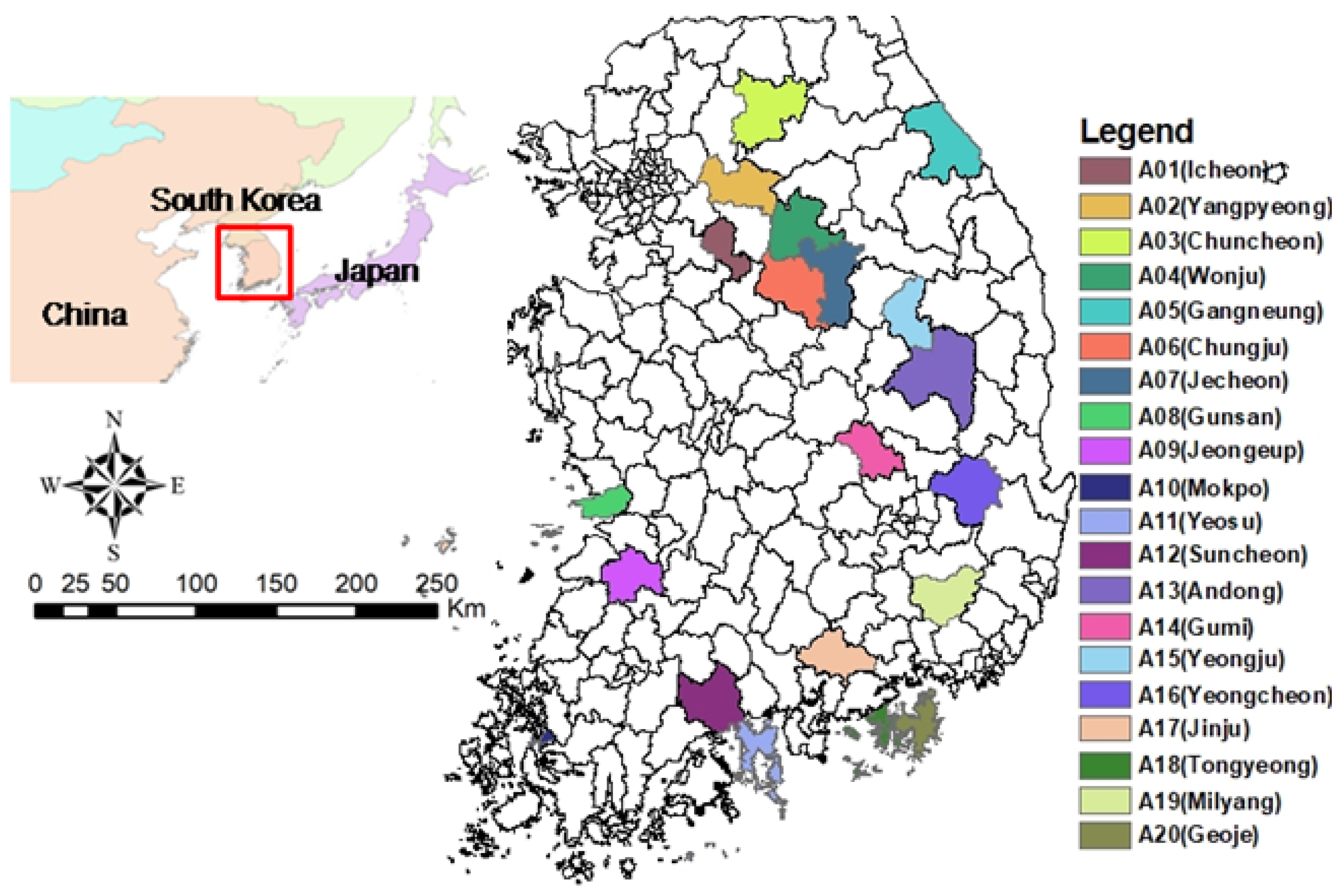
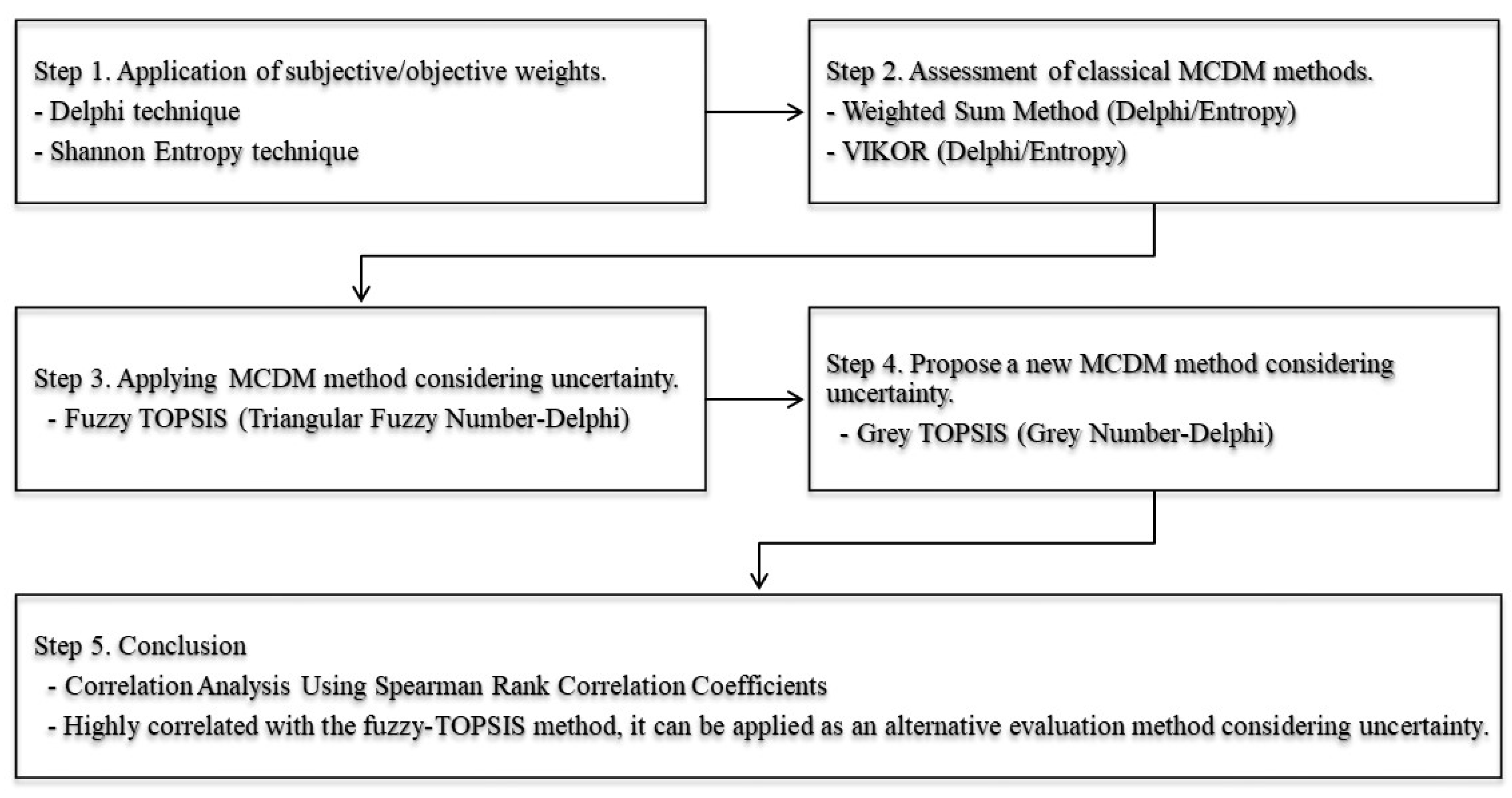
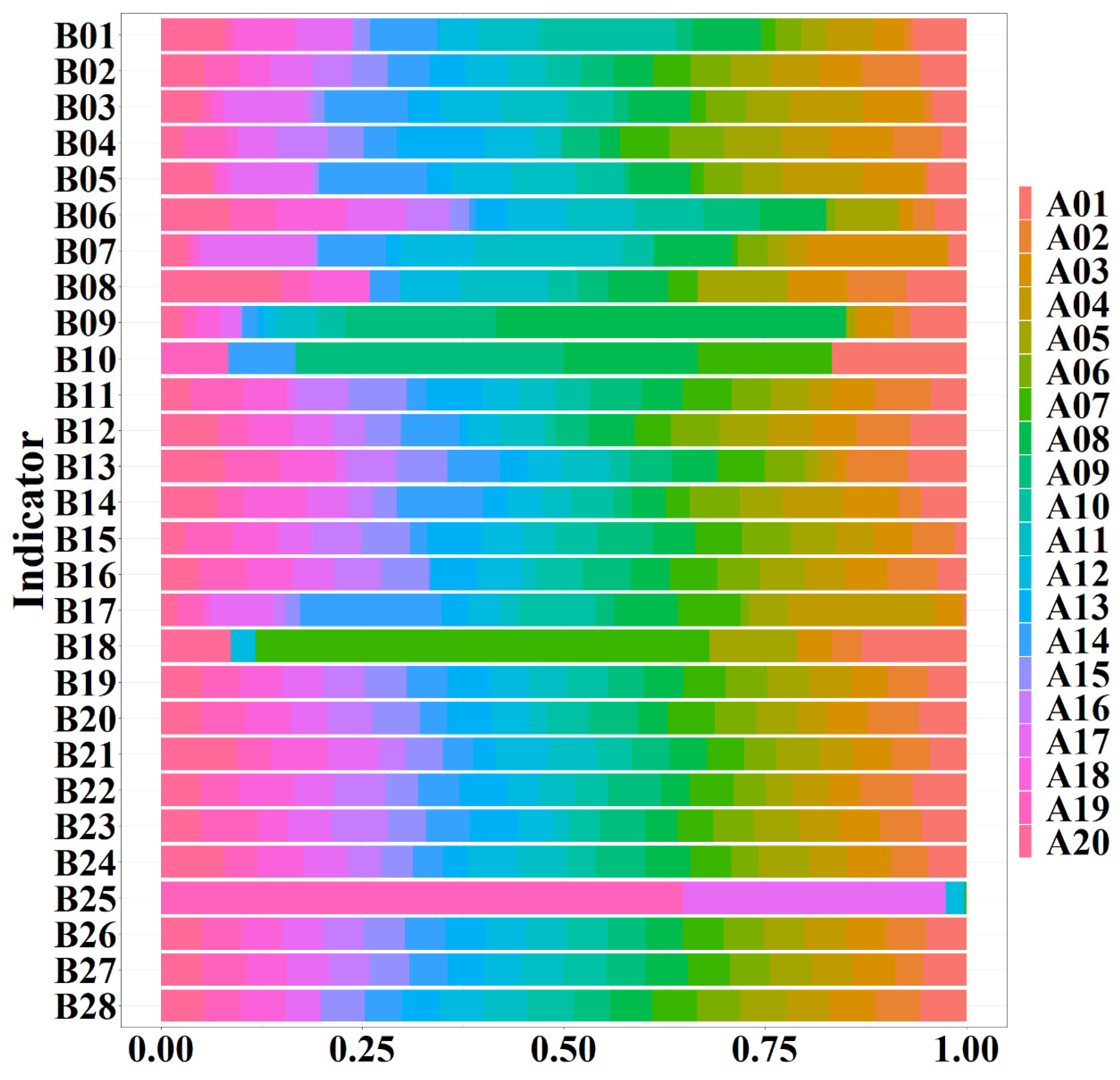
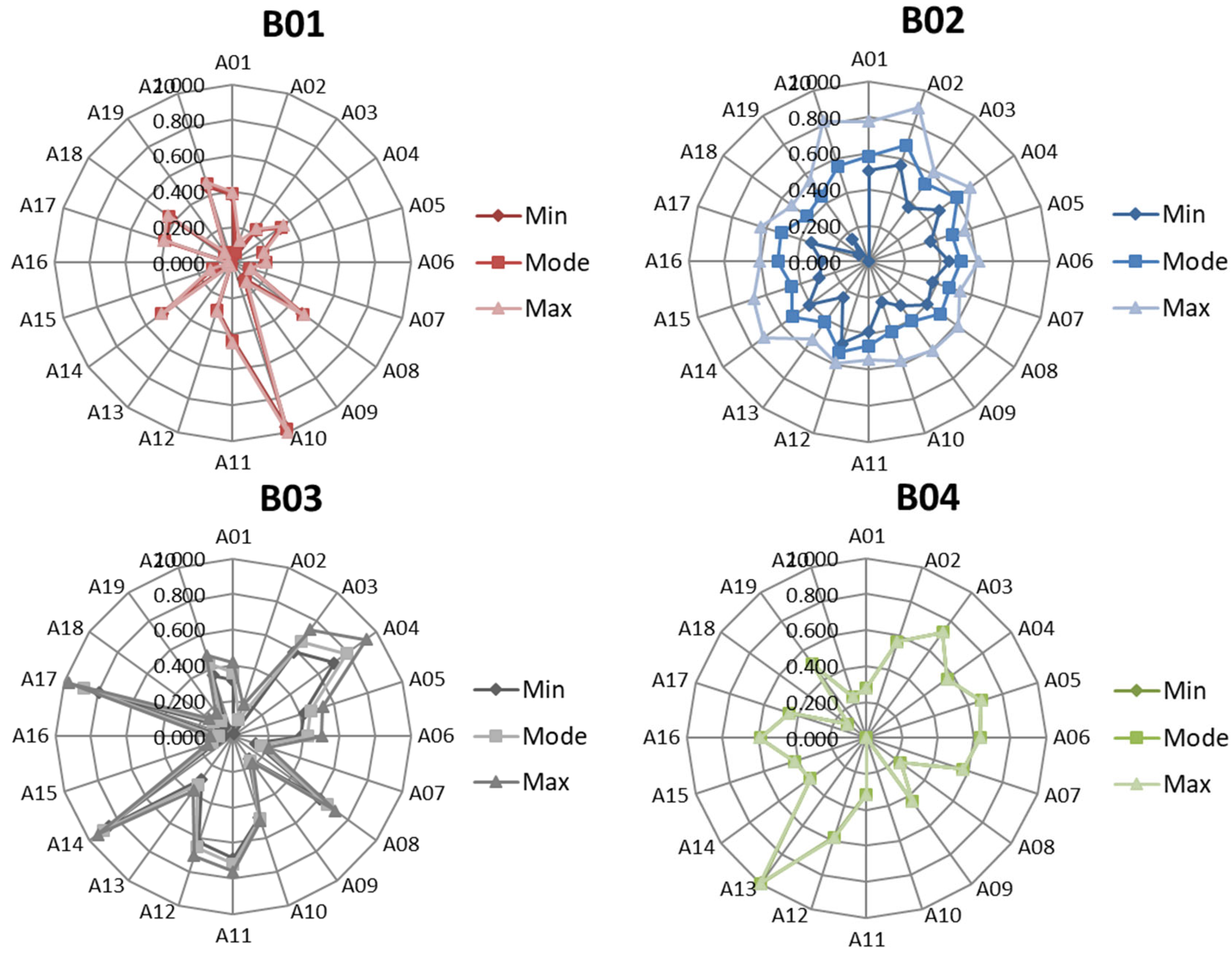
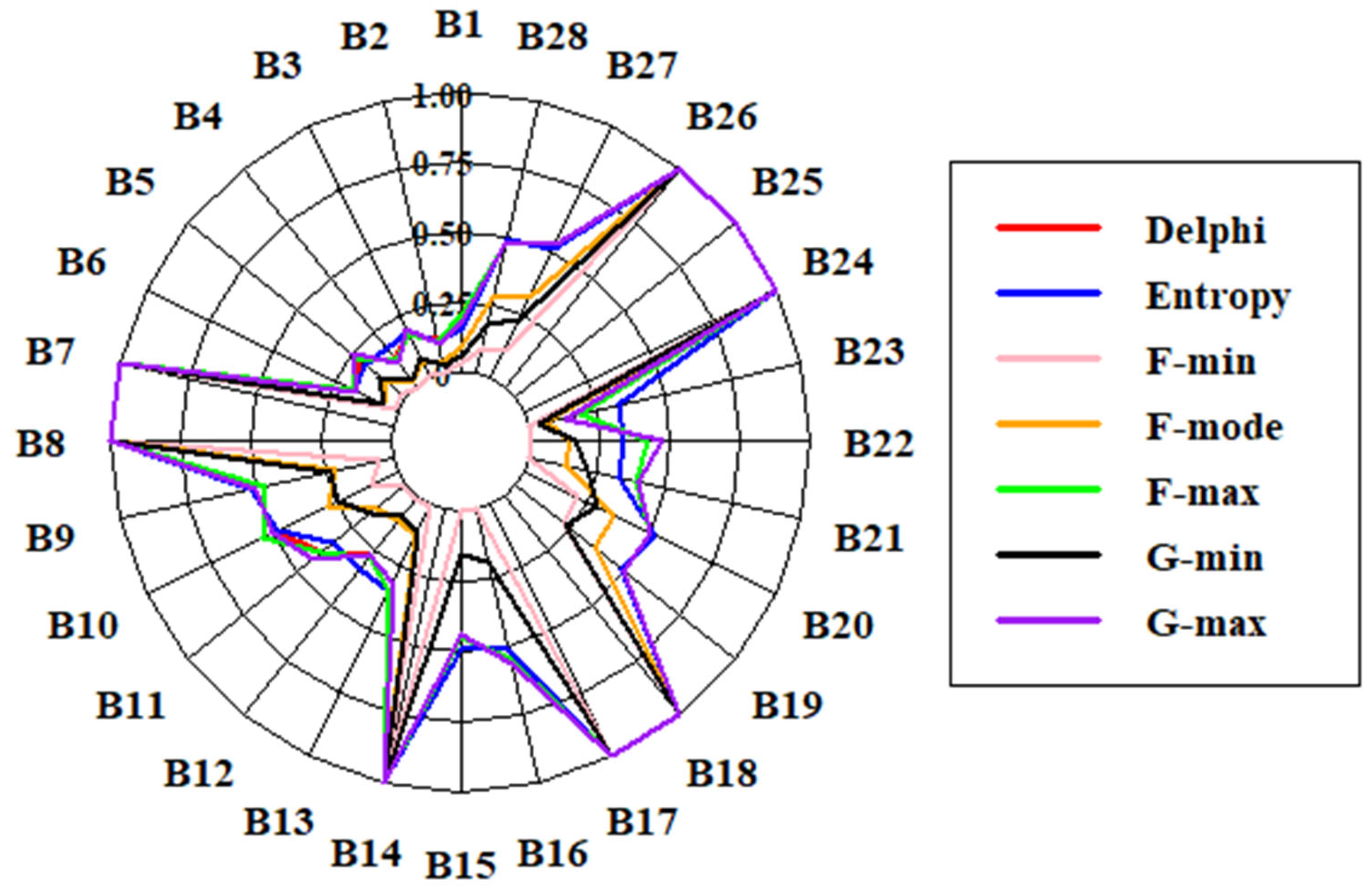
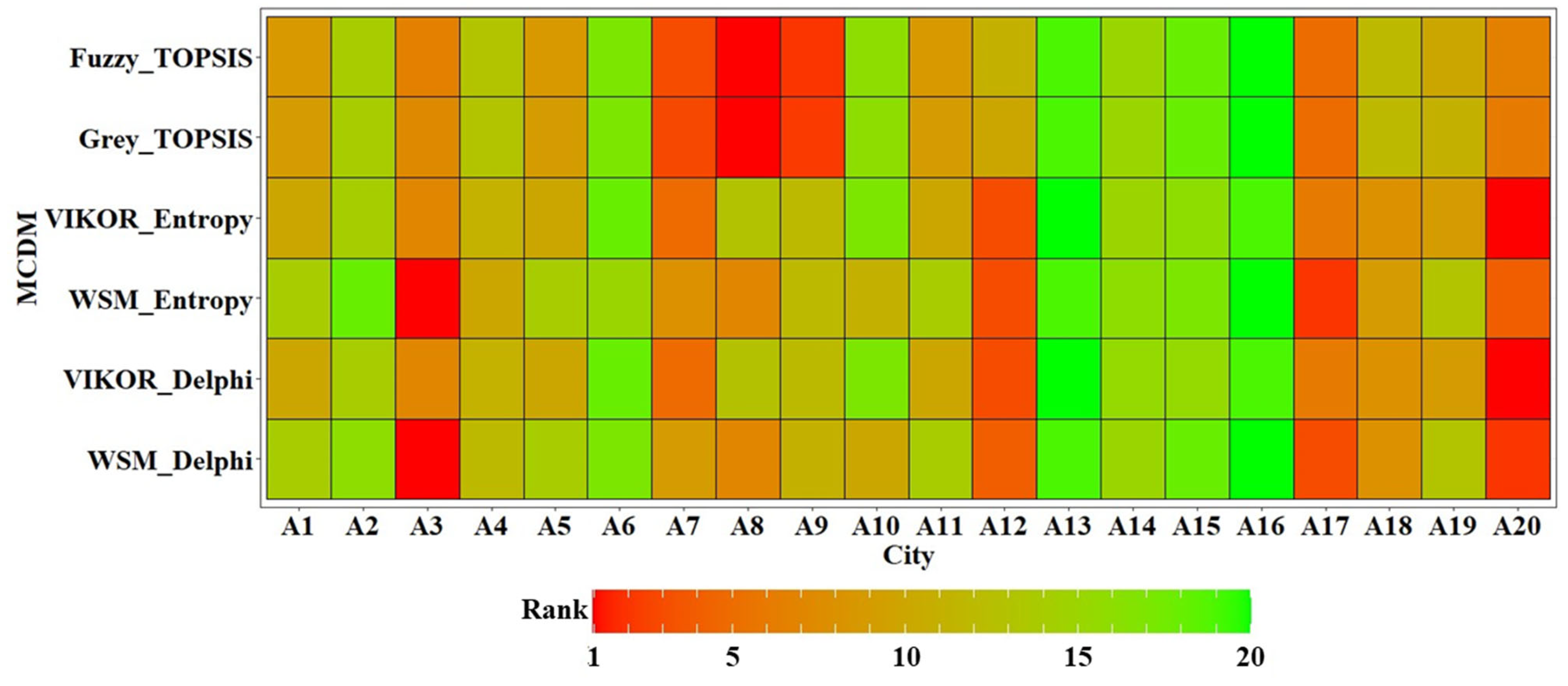
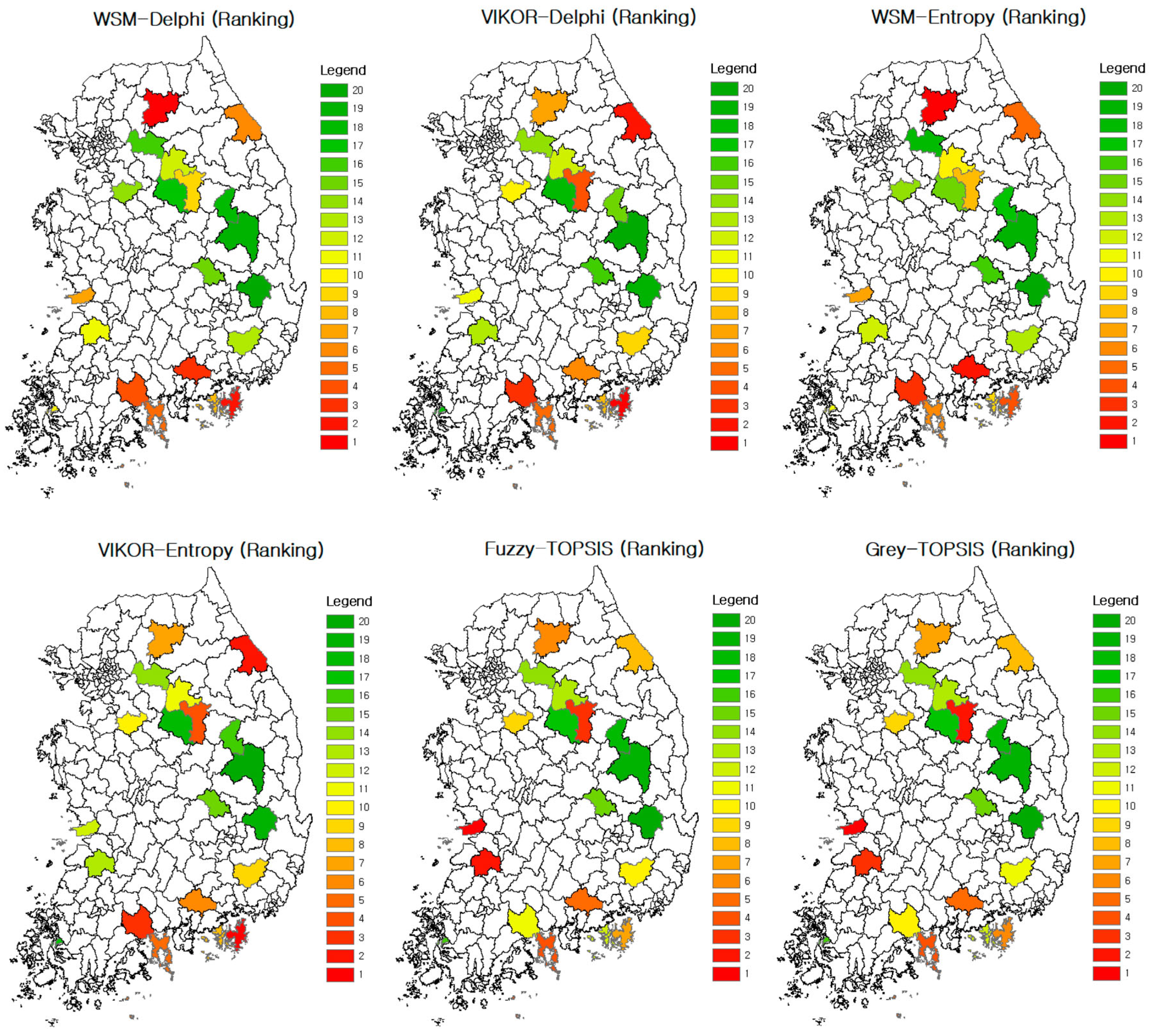

| No. | Cities | Label | Location | Area (km2) | Population | ||
|---|---|---|---|---|---|---|---|
| 1 | Icheon | A01 | 127°43′ E | 37°27′ N | (Inland) | 461.47 | 223,177 |
| 2 | Yangpyeong | A02 | 127°49′ E | 37°49′ N | (Inland) | 877.79 | 121,230 |
| 3 | Chuncheon | A03 | 127°73′ E | 37°88′ N | (Inland) | 1116.42 | 284,594 |
| 4 | Wonju | A04 | 127°92′ E | 37°34′ N | (Inland) | 868.25 | 357,757 |
| 5 | Gangneung | A05 | 128°88′ E | 37°75′ N | (Coast) | 104.07 | 212,965 |
| 6 | Chungju | A06 | 127°93′ E | 36°99′ N | (Inland) | 983.62 | 209,358 |
| 7 | Jecheon | A07 | 128°19′ E | 37°13′ N | (Inland) | 882.77 | 131,591 |
| 8 | Gunsan | A08 | 126°74′ E | 35°97′ N | (Coast) | 397.45 | 265,304 |
| 9 | Jeongeup | A09 | 126°86′ E | 35°57′ N | (Inland) | 693.10 | 106,487 |
| 10 | Mokpo | A10 | 126°39′ E | 34°81′ N | (Coast) | 51.66 | 218,589 |
| 11 | Yeosu | A11 | 127°66′ E | 34°76′ N | (Coast) | 512.26 | 276,762 |
| 12 | Suncheon | A12 | 127°49′ E | 34°95′ N | (Coast) | 910.95 | 281,436 |
| 13 | Andong | A13 | 128°73′ E | 36°57′ N | (Inland) | 152.22 | 156,972 |
| 14 | Gumi | A14 | 128°34′ E | 36°12′ N | (Inland) | 615.31 | 412,581 |
| 15 | Yeongju | A15 | 128°62′ E | 36°81′ N | (Inland) | 670.11 | 101,942 |
| 16 | Yeongcheon | A16 | 128°94′ E | 36°02′ N | (Inland) | 919.19 | 101,888 |
| 17 | Jinju | A17 | 128°11′ E | 35°18′ N | (Inland) | 712.90 | 347,097 |
| 18 | Tongyeong | A18 | 128°43′ E | 34°85′ N | (Coast) | 240.21 | 125,383 |
| 19 | Milyang | A19 | 128°79′ E | 35°50′ N | (Inland) | 798.64 | 103,525 |
| 20 | Geoje | A20 | 128°62′ E | 34°88′ N | (Coast) | 403.83 | 241,216 |
| Model | Resolution | Institution |
|---|---|---|
| ACCESS-ESM1-5 | 1.25° × 1.875° | Commonwealth Scientific and Industrial Research Organization |
| CanESM5 | 2.81° × 2.81° | Canadian Centre for Climate Modeling and Analysis |
| GFDL-ESM4 | 1.3° × 1.0° | Geophysical Fluid Dynamics Laboratory |
| CMCC-ESM2 | 0.9° × 1.25° | Euro-Mediterranean Centre on Climate Change |
| INM-CM4-8 | 2.0° × 1.5° | Institute for Numerical Mathematics |
| IPSL-CM6A-LR | 2.5° × 1.27° | Institute Pierre-Simon Laplace |
| MIROC6 | 1.4° × 1.4° | Japan Agency for Marine-Earth Science and Technology, Atmosphere and Ocean Research Institute and National Institute for Environmental Studies |
| MPI-ESM1-2-LR | 1.875° × 1.86° | Max Planck Institute for Meteorology (MPI-M) |
| MRI-ESM2-0 | 1.125° × 1.125° | Meteorological Research Institute |
| NorESM2-MM | 2.5° × 1.89° | Norwegian Climate Centre |
| Factor | Division | Label | Indicators | Source |
|---|---|---|---|---|
| Social | Driving force | B01 | Population density | Statistical Year book (https://kosis.kr/index/index.do, 2011–2020) (accessed on 30 November 2022) [73] |
| B02 | Population growth | |||
| B03 | Number of disaster vulnerable class | |||
| B04 | Area by administrative district | |||
| B05 | Number of population | |||
| B06 | Distance to the shore | |||
| Pressure | B07 | Developed area | ||
| State | B08 | Number of flood disasters | Disaster Year book (https://kosis.kr/index/index.do, 2011–2020) (accessed on 30 November 2022) | |
| Impact | B09 | Number of victims | ||
| B10 | Human injury | |||
| Response | B11 | Number of inhabitants per resident | Statistical Year book (2011–2020) | |
| B12 | Number of beds per thousand people | |||
| B13 | Number of doctors per thousand people | |||
| Economic | Driving force | B14 | Unemployment ratio | Statistical Year book (2011–2020) |
| Pressure | B15 | Financial independence rate | ||
| B16 | GRDP | |||
| State | B17 | Developing plan area | ||
| Impact | B18 | Amount of damage | Disaster Year book (2011–2020) | |
| Response | B19 | Recovery amount | ||
| B20 | Disaster prevention budget | |||
| Environmental | Driving force | B21 | Annual maximum precipitation | Meteorological Administration (https://www.weather.go.kr/w/index.do, 2011–2020) (accessed on 30 November 2022) |
| B22 | Predicted monthly precipitation (GCMs) | CMIP6 | ||
| B23 | Day maximum temperature | Meteorological Administration (2011–2020) | ||
| Pressure | B24 | Daily maximum precipitation | ||
| State | B25 | Damage area | Disaster Year book (2011–2020) | |
| Impact | B26 | Number of households to be restored | ||
| Response | B27 | Length of levee | Statistical Year book (2011–2020) | |
| B28 | Number of reservoirs |
| MCDM Method | WSM (Delphi) | VIKOR (Delphi) | WSM (Entropy) | VIKOR (Entropy) | Fuzzy- TOPSIS | Grey- TOPSIS |
|---|---|---|---|---|---|---|
| WSM (Delphi) | 1 | 0.845 | 0.981 | 0.842 | 0.735 | 0.750 |
| VIKOR (Delphi) | - | 1 | 0.844 | 0.997 | 0.704 | 0.735 |
| WSM (Entropy) | - | - | 1 | 0.841 | 0.714 | 0.731 |
| VIKOR (Entropy) | - | - | - | 1 | 0.690 | 0.722 |
| Fuzzy- TOPSIS | - | - | - | - | 1 | 0.996 |
| Grey- TOPSIS | - | - | - | - | - | 1 |
Disclaimer/Publisher’s Note: The statements, opinions and data contained in all publications are solely those of the individual author(s) and contributor(s) and not of MDPI and/or the editor(s). MDPI and/or the editor(s) disclaim responsibility for any injury to people or property resulting from any ideas, methods, instructions or products referred to in the content. |
© 2023 by the authors. Licensee MDPI, Basel, Switzerland. This article is an open access article distributed under the terms and conditions of the Creative Commons Attribution (CC BY) license (https://creativecommons.org/licenses/by/4.0/).
Share and Cite
Kang, H.-Y.; Chae, S.T.; Chung, E.-S. Quantifying Medium-Sized City Flood Vulnerability Due to Climate Change Using Multi-Criteria Decision-Making Techniques: Case of Republic of Korea. Sustainability 2023, 15, 16061. https://doi.org/10.3390/su152216061
Kang H-Y, Chae ST, Chung E-S. Quantifying Medium-Sized City Flood Vulnerability Due to Climate Change Using Multi-Criteria Decision-Making Techniques: Case of Republic of Korea. Sustainability. 2023; 15(22):16061. https://doi.org/10.3390/su152216061
Chicago/Turabian StyleKang, Hae-Yeol, Seung Taek Chae, and Eun-Sung Chung. 2023. "Quantifying Medium-Sized City Flood Vulnerability Due to Climate Change Using Multi-Criteria Decision-Making Techniques: Case of Republic of Korea" Sustainability 15, no. 22: 16061. https://doi.org/10.3390/su152216061







